Factory Boost Jets ??? - Yes and No.

and Controlled Boost Scenarios
Enough posts have been made now that everyone pretty much
knows the "FACTORY BOOST JETS" exist. Well, just to close the case, here
you go. On each side of the car, there are the factory boost solenoids. A
short hose from the intake/inlet pipe (to the turbo compressor inlet)
connects to the "top" (seen on bottom in these pics) port of the solenoid.
This is a vacuum signal and always a vacuum signal. The factory boost
signal hose (comes from front of engine bay from TB pipe nipple) connects
to one other port on the 'T' and the other port has a hose that goes down
to the turbo actuator. The bottom port of the solenoid has a small section
of hose that then connects to a metal 'T'. On this hose you will find a
bulge. In the bulde is a small restrictor. Note that this restrictor is
not directly inline with the boost signal line, so you could argue that it
is NOT a boost jet, but rather a solenoid signal/vacuum restrictor.
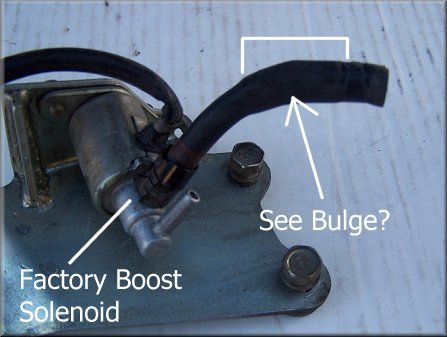

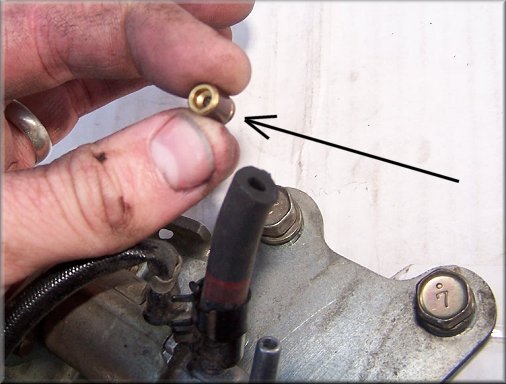
FACTORY SETUP

The factory setup is described in the diagram above. Each
side of the engine has this setup. The wastegate is PRE-SET to open when
seeing a boost signal of about 6-7 psi, while the setup is "calibrated" to
run the engine at about 9-10 psi of boost. When the factory boost solenoid
is OPEN (12v signal) the actual boost signal is bled off through the
solenoid into the intake tract...
So, the wastegate actuator sees less than actual boost
pressure (about 3 lbs less).
If the hole in the restrictor were smaller, the bleed off
would be less...if bigger, more. If you were to plug the line (or remove
the solenoid) and have a direct boost signal, the boost would be limited
to 7 psi. When the factory solenoid is closed (12v signal cut [safety
boost, cold engine, or startup]), you see about 7 psi max boost because
the actuator is receiving the actual boost signal pressure instead of the
"calibrated" signal.
One problem with this setup is that the wastegate actuator
sees a gradual rise is pressure. While boost is being introduced, the
signal bleeds off incrementally. So, when you are at 8 lbs of boost, the
actuator is seeing 5 lbs and can begin to open. Instead of opening only
when the exact preset level is matched, the operation can be slightly
inconsistent, creating a bit of lag in the spooling of the turbo. This
problem can be solved by using an EBC, as discussed below.
FACTORY SETUP (in SAFETY BOOST)
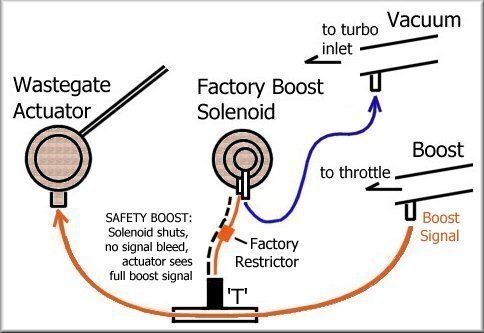
FACTORY SETUP w/AFTERMARKET BOOST JETS
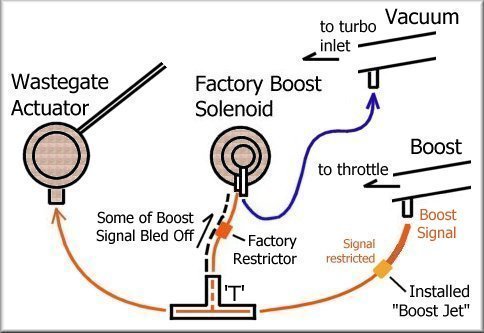
Now then -- you decide to install boost jets into the boost
signal line while keeping the stock solenoids installed. You put in .045
jets and are now running 14 psi. The boost jet is restricting the actual
boost signal, "tricking" the system and showing the actuator less pressure
(boost) than actual boost. The small hole in the boost jet allows less
pressure through the signal hose (about 4-5 psi in this case). The factory
solenoid further bleeds this signal (about 3 psi). The result is that the
actuator sees 6 psi of pressure when in actually you are running 14 psi
into the manifold. Another issue here, the signal is bleeding to the
actuator as boost increases. So, when you're at 10 psi, the actuator sees
2 psi. When at 12, actuator sees 4 psi. The actuator may actually start
moving once pressure is getting close the operating opening pressure, as
in the stock setup (discussed above).
Another issue with boost jets, also seen in the stock setup
(but not as serious), is boost spike. The boost level seen in the engine
can spike for brief moments before the actuator operation opens the
wastegate and holds boost at max. This can be dangerous for the engine,
leading to pre-detonation.
AFTERMARKET BOOST JETS w/FACTORY SOLENOIDS REMOVED
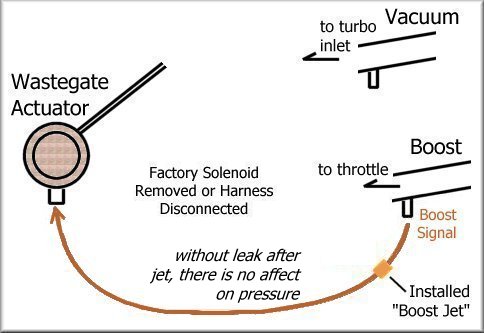
Now, you remove the factory solenoid and connect the boost
signal line directly to the wastegate actuator (or disconnect the
electrical connector). You still have boost jets in the boost signal hose.
What happens now? I was confused about this at first, but then the concept
was explained to me on TT.net. If there is no leak, the pressure on both
sides of the boost jet remains equal, even though there would appear to be
a restriction of flow and less pressure on the other side. So, throwing in
boost jets on a dedicated line to the actuators does NOTHING. However, if
you remove the line or plug it completely, the actuator can never open and
you will hit "infinite boost".
ELECTRONIC BOOST CONTROLLER (EBC) with SOLENOIDS REMOVED (or
unplugged)

Last, you install an EBC. All the sudden there is a
different operation. (not a full or precise explanation, but you can find
out all about EBC's on TT.net). The EBC solenoid provides NO SIGNAL to the
actuator until the precise moment you reach the maximum set boost. What
does this mean? The actuator sees NO PRESSURE and will not start to open
until EXACTLY when full boost is reached, at which point it opens
immediately. The EBC either opens and closes this signal quickly or will
bleed a bit of pressure (like the factory solenoid) to maintain pressure
at exactly what is set. This provides better spooling and quicker boost
response. Advantage EBC.
THERE YOU GO.








